Genre: Fighting Developer: Bandai Publisher: Bandai Players: 1-2 Released: 1994
Many gamers today are familiar with the world of Dragon Ball Z, the most popular series in the Dragon Ball mythos (comprising of manga and anime), which has aired in the U.S. since 1996. The series has seen an increase in popularity over the last console generation, resulting in numerous domestic game releases. While it now feels as if there is a new DBZ game out every few months, Americans weren’t always so lucky. Due to the large gap between U.S. and Japanese air dates (the series began its run in 1989 in Japan), many DBZ games never made it here. This was a shame because a few were quite good. One of these games is Dragon Ball Z: Bu Yu Retsuden, a game that can be enjoyed by Dragon Ball and fighting fans alike.
The only DBZ release for the Sega Mega Drive, Dragon Ball Z: Bu Yu Retsuden, was an innovative two-player fighting game in a time where most other examples of the genre could be considered Street Fighter II knockoffs. Bu Yu Retsuden separates itself in a couple of different ways. Unlike most games of the time, fighting wasn’t limited to a single plane. Fights could take place in both the air and on the ground. Of course, being able to fight on two different planes in a single stage required some creative developing, which leads to the its next innovation: split-screen-fighting. Instead of focusing on both characters, the screen splits vertically in half whenever the characters put a good amount of distance between each other. When you get back into close-range combat, the split-screen disappears. As you can imagine, this allows for some huge stages. Bu Yu Retsuden also features a standard power bar, and a “Ki” bar. In order to perform some of the larger ki blasts, a certain amount of ki must be charged, which you accomplish by holding down A and B simultaneously. These innovations, along with a variety of ways to defend, created a fighting game that was as equally strategic as it was frantic.
Bu Yu Retsuden utilizes the Genesis three-button controller better than any other fighting game I’ve played. One button to punch, one button to kick, and one button to switch from air to ground battles. While not having light, medium, and strong attacks may seem like a negative, Bu Yu Retsuden is surprisingly deep. In fact, it’s deeper than most Genesis fighters. The game relies heavily on simple direction + button combinations to pull of complex maneuvers (it’s also worth mentioning that all combinations can be viewed in the pause menu during a battle). Pulling off simple ki blasts or four-hit combinations are as easy as throwing a hadouken in Street Fighter II. Some of the larger attacks though, require a little more work and precision. Memorizing your favorite character’s move set is not only extremely rewarding but, because of the Genny’s D-pad, very easy. The circular pad is perfect for the often-required half-circle motions.
The graphics in Bu Yu Retsuden are a mixed lot. Characters are well drawn, detailed, and colorful. The backgrounds, on the other hand, are almost uniformly bland. Rather than colorful architecture behind you when you fight, Bu Yu Retsuden instead uses a lot of similar landscapes. You’ll be fighting in front of boring hills, deserts, and oceans, which is a little disappointing when compared to other fighters of the era. The animations for each of the characters though are nice and smooth. Fans of the series will appreciate the attention given to various super moves, like the Kamehameha and the Big Bang attack. All moves and animations are instantly recognizable.
The sounds complement the fighting quite nicely. Sound effects for moves are what you would expect from a 16-bit fighter: there are grunts, blasts, and bangs; and the music for each stage achieves conveying the frantic pace. It all works pretty well, and not once did I feel the need to press mute and turn on my cd player, but you probably won’t be humming the game’s theme after playing.
Obviously, I really enjoyed Bu Yu Retsuden. But before I recommend purchasing it, I should go over some quick importing notes. The game has a comprehensive story mode, but of course, it’s in Japanese. Playing through the story mode without knowledge of the language is equivalent to playing an arcade progression mode, so it’s not too big of a deal. Other than the story mode, everything else is extremely easy to decipher, and there are plenty of websites around with complete move lists available. Bu Yu Retsuden will also play using any pass-through cart, including the inexpensive Game Genie. The game is fairly easy to find through sites like ebay, and it usually costs between $20 and $40 for a cart-only or complete copy.
If you’re looking for an original take on the fighting genre, you can’t go wrong with Dragon Ball Z: Bu Yu Retsuden. It’s innovative, colorful, and great fun for one to two players. It is absolutely one of the better licensed games on the Genesis, and well worth the trouble of importing. If you can find a complete copy of this game for around $30, I wholeheartedly recommend buying it.
SCORE: 8 out of 10

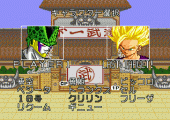
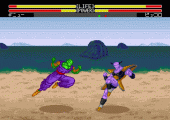
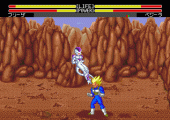
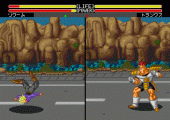
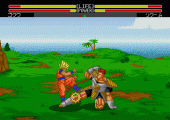
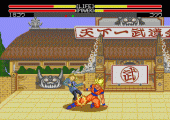
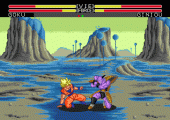
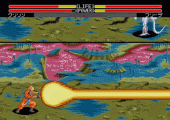
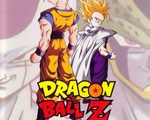
Recent Comments